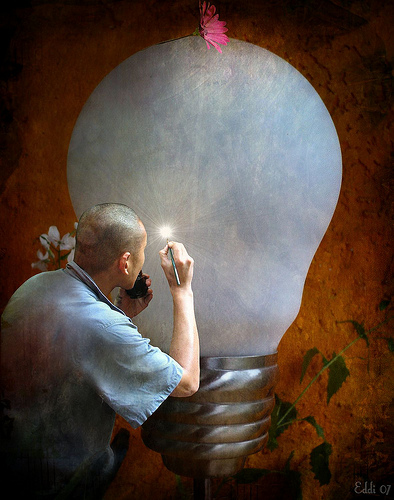I was shopping at my local big-box store last week, just trying to save a little money and hoping to benefit from their considerable buying power. Seeing that light bulbs were on my list, I turned down the Households isle and stopped in front of the display.
There wasn’t a “regular bulb” in sight, though. The shelf was stocked with those curlicue things properly called compact fluorescent lights (CFLs). You know, the ones that look like pretzels made of glass.
“Oh well,” I thought, “everything changes.”
Figuring Edison’s incandescent bulb had become just one more memory for the good old days, I leaned over to select a carton of eight bulbs. That’s when I saw the price: $15.
How can it be that much at the chain store?
I drew back like I’d stuck my finger in a live socket and told my dear, sweet spouse, “I’m not paying that.”
And I didn’t.
It took a little looking (and more gasoline expense than it was worth), but I finally found some “regular bulbs” at a different store for a buck each. I’ll begrudgingly pay $8 for eight light bulbs, but darned if I’ll pay almost twice that much for the new-fangled version. At least, that was my thinking …

Was it a smart decision?
Here’s what I found out.
If you believe the hype (I’m not jumping on anybody’s bandwagon without checking it out first), CFLs will last about 10 times as long as the old style. It doesn’t take a math whizz to work that out. If they cost twice as much, but last ten times longer, then the relative cost is about one-fifth that of incandescent bulbs.
I certainly felt better about spending one dollar each on the old style, instead of two dollars on the new—but the proponents of CFLs say I will need to buy five incandescents to get the same amount of light. Financially, it would appear (if you believe the CFL lobby), my decision was not correct.
How about the power bill?
Which bulb is easiest on electricity, though?
My electric power bill this past winter appeared to be in a race with the pump at the gasoline station to see which could dig deeper into my pockets. And I heat with natural gas! Even Einstein wouldn’t be able to figure that one out.
Will the new-style bulbs push the monthly electricity burden up even higher?
According to the experts—Duke Energy, for example—the CFL bulb uses only about a quarter the amount of wattage, saving about $30 in electricity over the life of the bulb.
That possibility really got my ears perked up. Once more, I’m not sure I believe it, but I enjoy paying my power bill about as much as going to the dentist and dropping a few hundred bucks (after insurance) for a sore mouth.
Could CFL’s cut my monthly homage to the electricity magnates?
What is the downside to the CFL story?
According to the information I found, there are two primary complaints about CFLs.
The first is probably just a sign that some people (I’m not mentioning any names) are reluctant to embrace this new technology. They complain that the light given off by CFLs is “cold” and uninviting—nothing at all like the warmth emitted by their old incandescent friends (bulbs, I mean). Given that incandescent bulbs are being regulated out of existence and will soon be completely gone from store shelves, light-lovers are just going to have to get over it and belly up to the CFL counter.
The other complaint about CFLs, though, is a little more serious. It seems they contain mercury—and mercury is a lethal poison (both to you and to the environment). The good news is that mercury doesn’t escape from a CFA unless the glass is broken. The bad news is that, if it does break, you have a micro-example of a toxic spill on your hands: keep the kids and pets away, open the windows for ventilation and use a broom—not a vacuum cleaner—to clean it up.
Surely there are options
The relentless march of technology (and the never-ending need for the consumer to buy the next new thing) will provide options to the CFL, no doubt.
The most likely candidate, right now, is the already familiar light-emitting diode (LED) bulb. They are even more efficient that CFLs, but they come with their own set of difficulties.
For one, LED bulbs are considerably more expensive (and thats about all I need to know about them). But there is more: even though they don’t pose the mercury problem, the LED contains lead and arsenic.
Remember what we said about the kids and the pets? Keep them back and get out the hazmat suit.
All told, you get to make your own decision about light bulbs, and I get to make mine.
I took the leap
I ended up going online and ordering 16 CFL bulbs at a price that beat the big-box deal. To date, I’ve found the light quality way variable–some are okay and some are horrible. Moreover, I’ve experienced blown CFL bulbs after a short service life.
Will I buy CFL the next time around?
I doubt there will be any other option.
Featured images:
- License: Creative Commons image source
Someone told author, Casey Windsong, it is possible to change your life by writing about it. Casey isn’t sure that will work in all cases, though. Thomas Edison can’t be happy about the new bulbs. Casey isn’t either.










Comments